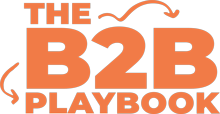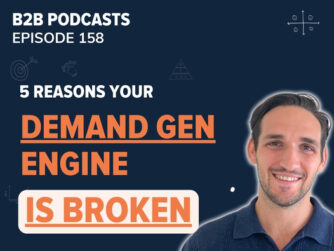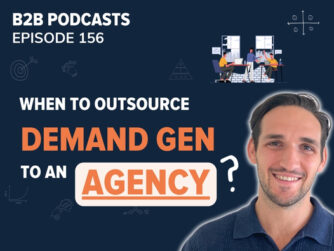Most people reading this article have probably tried to use AI to help with their B2B marketing at some stage. Whether it’s creating content, helping you craft an outbound sequence, or getting it to put together images and creative for you – the possibilities are endless. It promises so much, and yet, after an initial period of feeling amazed by it, it doesn’t quite help us as much as we think it will.
And in the end, we decide it takes more time than it’s worth, and go back to doing things the ‘old fashioned’ way.
But when used the right way, AI can be incredibly helpful and deliver on both the quality and quantity of your output. So that’s why we had AI and B2B Marketing expert Drew Brucker (from Brainchild) on The B2B Playbook to give us 3 practical use cases of AI right now – as well as a prompting framework you can use to execute any task.
Drew very generously shares his prompting frameworks, and screenshares using ChatGPT and Midjourney LIVE as he’s using it. So make sure you follow along and apply these learnings by listening, watching or reading below!
Listen To The Episode
Watch The Episode
What Is Generative AI?
Generative AI is essentially this idea that you can use AI to create something new. It could be text, images, video, whatever it might be. And the reason this is so transformative is that it’s not just about creating something out of nothing. It’s about augmenting the creative abilities of humans to produce things they couldn’t before, or to do so more efficiently and effectively.
In the context of marketers, generative AI helps “humans create things that we might not be able to on our own or do it more efficiently”
Drew Brucker – The B2B Playbook – [00:05:46]
It’s an incredible opportunity for small, time-strapped teams with limited resources because it enables them to get more done and chip away at the lofty goals set in front of them.
Even at The B2B Playbook, AI plays a key role in our content repurposing system. It’s this system which is what allows us every week in about 4-5 hours to create:
- 40 minute podcast
- 30 minute YouTube video
- 12x LinkedIn posts
- 3x articles
- 1x newsletter
- 12x TikToks
Every. Single. Week.
Where Do Most Marketers go Wrong with AI?
One big reason that Marketers don’t get a lot of AI and give up on it is because of their initial approach and expectations. He categorizes users into three stages – tourists, commuters, and locals – to illustrate the varying levels of engagement and expertise with AI tools. The key mistakes include:
- Tourists: Users with fleeting engagement, either overestimating or underestimating AI capabilities due to limited exposure.
- Commuters: Those with occasional use, gaining some familiarity but lacking deep understanding or mastery.
- Locals: Regular users who deeply understand AI’s capabilities, actively explore its potential, and integrate it effectively into their routines.
The goal of this article is to get you to become a ‘local’. The live examples below and frameworks from Drew should help hook you enough to get you there!
But before we dive into that, here’s a few more pitfalls to avoid when it comes to using AI for marketing.
Mistake 1: Overemphasis on Speed Over Quality
I think we’ve all been guilty of this one – throwing a prompt into ChatGPT to write an article for us, expecting it to do it in 30 seconds. And the output? Extremely underwhelming.
Proper use of AI will save you time, but not the enormous amount of time you’d expect. For example, when we first set out to use ChatGPT to help us turn our podcast transcript into articles, I was pretty disappointed at the output it gave me. Sure it only took 15 seconds, but it was unusable!
“People get excited about the speed at which AI can generate results. They think, ‘Oh wow, it’s so fast, it must be good,’ but then they’re disappointed because they haven’t really thought about the quality of what they’re asking for”
Drew Brucker – The B2B Playbook – [14:48]
Over time I realised I needed to develop a prompting framework to massage the answers out of ChatGPT. And the result was that it took a 4 hour task down to a 1 hour task. That’s still an enormous time saving of 3 hours! Not quite the 15 seconds I expected it to do it in intially, but still absolutely worth using.
So knowing how to effectively prompt or guide the AI to achieve the results you’re after becomes very important.
Mistake 2: Insufficient Prompting
If you’re not getting what you want out of your AI, chances are you’re not providing enough context or specific instructions. You’re expecting AI to deliver high-quality outputs without adequate guidance. This misalignment of expectations versus reality can lead to frustration and underutilization of AI’s capabilities.
“The biggest mistake I see is that people either don’t give enough information in their prompts, or they expect AI to read their minds. You have to be clear about what you want if you’re going to get useful results”
Drew Brucker – The B2B Playbook – [09:37]
It’s not a mind reader! That’s why creating prompting frameworks you can use again and again become a great time saver and help you get the most out of AI in the shortest amount of time.
So, Drew suggests that the more you understand and experience AI tools, the more effectively you’ll be able to use them. This approach helps in transitioning from viewing AI as a mere speed tool to recognizing its potential for enhancing quality and creativity in outputs.
Read on for Drew’s frameworks and live examples of how to use AI in B2B marketing.
AI Prompting Frameworks: Why They’re So Important
Prompting frameworks are what allows you to save time and repeat a process whenever you have a successful outcome using an AI like ChatGPT. AI’s like ChatGPT have a ‘custom instructions’ section where you can plug in a bunch of context and constraints or directions. The more of these you enter, the more tailored and effective your AI can become.
We keep track of our favourite ones in a Google Sheet! That way when it comes to our repurposing process for our content, we’re just copying and pasting our prompts into ChatGPT, knowing it’s going to give us the output we’re after faster.
Use Case 1 for AI in Marketing: Brainstorming
Generative AI are extraordinary at brainstorming right now. This is super handy especially if you’re working remotely – because, let’s face it – it’s pretty hard to be creative over a Zoom video call.
Drew gives an awesome example as to how he used ChatGPT to help him theme and brand a customer event for his old company, Lasso. Playing on the brand name, and with Drew’s instructions around the ‘Wild West’ influence the Lasso brand has, Drew shares his interaction with ChatGPT to brainstorm ideas:
“Give us some names. Campfire. Okay, perfect. That sounds intimate. Sounds like a small group, which is exactly what this was. Now let’s think about like the experience that we’re gonna have on site of the event. What do you think would go with this?
Drew Brucker – The B2B Playbook – [23:51]
Oh, scented candles that have like a campfire smell. Things like drinks and the names of those drinks that are on brand with campfire, right? So you got some really, neat and markety type names to, to build out this experience, right?
And so ideation is so massive, whether it’s for something like a customer only event it’s the name of your email newsletter, it’s the name of all the different possibilities that exist within words that you use, right?”
Anything you do that feels painful, tedious – or you just need a kickstart – make sure you give it a crack first with an LLM like ChatGPT.
Use Case 2 For AI In Marketing: Creating Images For Your Brand (no more stock photography!)
Marketers know the pain of trying to find images that feel like their brand. Stock photos never quite do the job, and hiring a photographer to take photos is damn expensive, and probably not in your budget.
And authentic brand visuals significantly shape how people perceive your brand. How can you be authentic if you’re using the same images that everyone else is?
Drew shows us how you can use AI’s unique ability to generate custom, brand-aligned visuals efficiently and cost-effectively. Midjourney is his weapon of choice as the AI tool he uses to generate these custom brand visuals.
Live Example Of Using Midjourney To Create Brand Images
Drew walks through below how he uses his prompting framework to create images for Lasso (the old company he worked for).
His prompting framework creates something that feels like his brand, and looks like his Dream Customers. The results are pretty incredible – make sure you watch the video above.
You can also watch Drew iterate on his prompts in real time to get the output he’s after. This is a skill that everyone needs to master.
Imagine creating a whole library of images like this that you can use on demand? Now imagine having a prompting framework that you can input into Midjourney to create more images whenever you want that are perfect for your brand?
That’s exactly what Drew helps businesses do – and what you should also have a go at doing yourself!
Use Case 3 For AI In Marketing: Create an Outbound Email Sequence
Drew also demonstrates the power of a prompting framework by creating ‘Outbound GPT’. This uses ChatGPT to help suggest outbound email sequences that will land you more meetings.
He shows us the importance of proper context, specific goals, and detailed instructions to achieve better outcomes with AI-generated content. Here are the key points Drew makes about setting up ‘Outbound GPT’:
- Setting Proper Context: Drew starts with establishing a clear context for the task, specifying the role of the AI as a digital marketer specializing in cold email outreach. This foundational step ensures that the AI has a clear understanding of its objective and role.
- Defining Goals and Outcomes: He emphasizes the importance of defining the goal of the prompt, such as creating five cold email templates, and outlines the expected use of these templates, indicating a forward-thinking approach to prompt construction.
- Specifying the Format and Specifics: Drew details the structure and elements he wants in the cold email, such as the subject line, personalization, and call to action (CTA), demonstrating a meticulous approach to guiding AI outputs.
- “Cold email structure, I want you to come up with a subject line, a personalization address an elephant in the room, right?” (Timecode: 00:41:30).
- Providing Additional Information: He mentions the importance of providing extra details about the business, target audience, and the tone of voice to tailor the AI’s output more closely to his needs.
- “Here’s my target audience that I’m sending for this email. Here’s my business, right? Here’s the desired CTA” (Timecode: 00:42:50).
An important less here that you’ll get from watching the video with Drew is that this is an iterative process. The AI will not get it 100% right from the beginning. But if you give it feedback and work with it, it will get much closer to the desired output a LOT faster.
Pretty awesome!
What Next?
Make sure you check out Drew Brucker and follow him on LinkedIn. He drops so much gold there everyday on how to use Midjourney and AI to make your life easier as a marketer. Also check out his website Brainchild if you want to see how he can create a whole library of images like these for your brand, and give you the frameworks so you can do it without him in the future.
We also did an episode where we share our own advanced content repurposing framework which uses AI tools to create content in a fraction of the time. Make sure you check that out here too.
(P.S. content repurposing using AI is also something we cover in our Demand Generation program – The B2B Incubator. Check that out below!)








